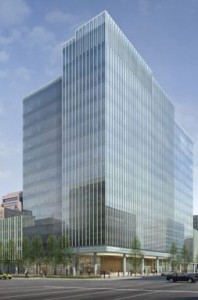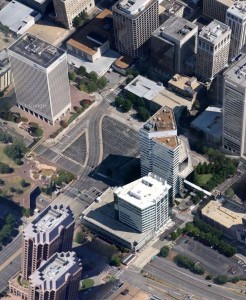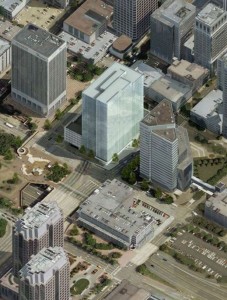Richmond City Council has approved $11.25 million in general obligation bonds to build a public parking garage for the proposed Gateway Plaza, a $110 million office tower in downtown Richmond. I’m often skeptical of municipal “incentives” to stimulate “economic development” projects, but I think this undertaking will withstand scrutiny.
Chicago-based Clayco has contracted to purchase two lots — currently used for surface parking — in the heart of Richmond’s central business district. In their place, the developer would erect a 275,000-square-foot tower with the McGuire Woods law firm as the anchor tenant and a structured parking deck immediately adjacent.
From a high-altitude perspective, this deal looks favorable to the city. Not only does the project add $110 million to the tax base, which should yield $1.3 million in tax revenue at the current tax rate, it will repair a gaping hole in downtown’s urban fabric.
Judging from the design details released by Clayco, the project will be conducted with an eye toward appropriate urban design. The building will not resemble the monstrosity next door (seen in the upper-left hand corner of the photo below), owned by Dominion, an example of the “radiant city” school of architecture that glorifies the office tower — a pedestal set upon an empty plaza — at the expense of human scale and street connectivity. Aloof and isolated, the Dominion building sits there like an undigested lump.
By contrast, the base of the Gateway Plaza building will extend to the sidewalk, inviting interaction with the city. The ground level will include 10,000 square feet of retail, including a cafe-bistro and amenities such as dry cleaning and shoe repair. As a gold-level, LEED-certified building, Gateway Plaza also will provide electric car chargers in the parking deck and bicycle racks.
Perhaps the project’s greatest contribution will be eliminating an eyesore — a surface parking area lacking redeeming features of any kind — that deadens the walking experience along Cary Street. The project will go a long way to improve walkability in the heart of downtown Richmond, which will make neighboring properties more desirable and valuable. It’s the kind of project that could stimulate more investment, market conditions permitting, in the surrounding area.
The city is financing construction of the parking deck to the tune of $11.25 million and raising the cash by selling general obligation bonds that will be paid by incremental gains in real estate taxes, as well as a separate performance-based grant to be repaid by gains in BPOL and personal property taxes, according to Tammy Hawley, press secretary for Mayor Dwight Jones. “It is not a subsidy.”
Subsidies are in the eye of the beholder, I suppose. When Bacon’s Rebellion pays taxes on its office building (I don’t really have an office building, but go with me here), Henrico County doesn’t take 10% of the revenue in added tax revenues to, say, add curb and gutter along my property, and my property only. I would be getting a benefit that others don’t get.
On the other hand, let’s assume the city issues 20-year bonds at the current interest rate of 3.5%. The financing costs would be roughly $780,000 a year, leaving a positive cash flow from real estate taxes of about $500,000 a year. That does not include tax revenues from the ground-level retail sales or incidental expenses incurred making street improvements to accommodate the new traffic flow. Clearly, there would be a net benefit to the project. And, just as important, there would be little risk to the city. Regardless of how the developer fares financially, the bump to the tax base does not go away.
Gateway Plaza is not like the City of Norfolk’s borrowing $31 million to build a cruise line terminal, the success of which was contingent upon cruise liners home porting in Norfolk. (See “Norfolk’s Cruise-Line Gamble Could Turn Up Snake Eyes.”)
My only question is whether the city really had to chip in the $11.25 million subsidy to make the deal work. In situations like this, developers will always ask for the money. They would be negligent if they didn’t. I would be interested to know what kind of due diligence city officials conducted to assure themselves the deal would have cratered without the contribution.
Note: I have edited the original post to incorporate information provided by the City of Richmond.





